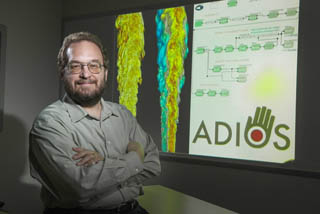
Jay Lofstead (1423) is the fourth Sandia winner of an R&D100 award this year. His Sandia affiliation inadvertently was not listed in Oak Ridge’s winning ADIOS code entry. Jay was one of the initiators of that technology.
ADIOS, which stands for Adaptable Input/Output System, a high-performance input-output software that can access data from storage and from data streams. It was originally developed to help run fusion plasma codes, which typically must handle billions of particles in high-fidelity simulations. Since its inception, the code now has been used in supercomputer calculations involving combustion research, earthquake simulations, quantum physics, computational fluid
dynamics, climate research, and weather forecasting.
It maintains adaptable, easy-to-use, and scalable I/O plug-ins across a variety of platforms. The software framework is designed to handle the input/output requirements of current and future “big data” applications, where efficiency and portability are a must.
Among its advantages are data staging methods that allow independent applications to run concurrently for memory-to-memory data exchange, thereby streamlining workflows. Potential applications lie in cloud computing and financial services.
R&D 100 awards focus attention on research ideas that have been put into use, in contrast with more typical science awards that honor pure research. Since 1976, Sandia has won 105 R&D 100 awards.
Sandia’s three other winners this year (see Lab News, July 26) are Bruce Burkel, for the Membrane Project Lithography team; Mike Heroux, the Mantevo project; Cliff Ho and Cianan Sims, the Solar Glare Hazard Analysis Tool.